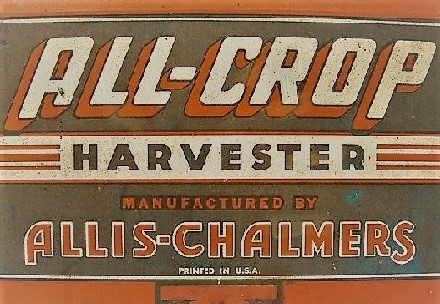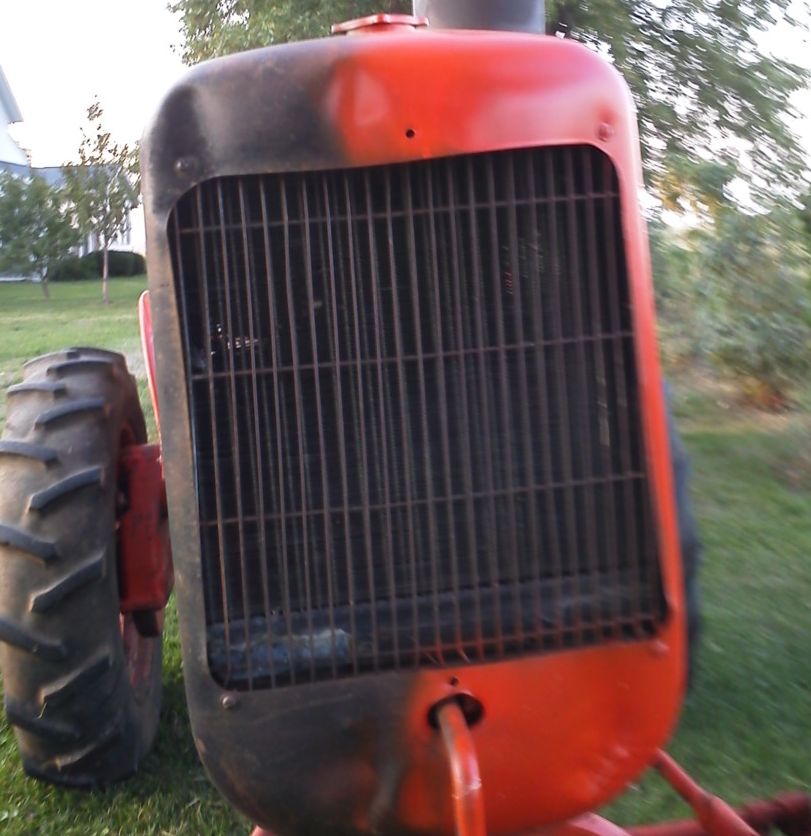| Author |
 Topic Search Topic Search  Topic Options Topic Options
|
Gerald J. 
Orange Level

Joined: 12 Sep 2009
Location: Hamilton Co, IA
Points: 5636
|
 Post Options Post Options
 Thanks(0) Thanks(0)
 Quote Quote  Reply Reply
 Posted: 24 Jan 2016 at 10:26am Posted: 24 Jan 2016 at 10:26am |
|
There is some data about gear ratios in the Nebraska Tractor Test data I linked above. At least enough to compute the overall gear ratios.
From that test data full load in each gear at maximum rated RPM, the B did 2.42, 4.22, and 8.46 mph at 1501 RPM. The CA did 1.70, 3.17, 4.15, and 10.91 at an average 1652 RPM. Both used 10-24 tires.
The transmission obviously is different, but the differential ring and pinion and the drop box ratios all have an effect. The appropriate parts books might hint at those ratios.
For computing I used the 129 inch circumference of modern 11.2-24 tires.
I compute the B overall ratio engine to rear wheel ratios at 69.68, 40.86, and 21.09. The CA ratios at 102.56, 58.38, 45.655, and 18.10.
I took the reported ground speed, adjusted by dividing by 1.0 - slip, to get tire speed in mph. Mph x 5280 gives feet per hour times 12 gives inches per hour divided by 129 gives revolutions per hour divided by 60 gives RPM. RPM divided into engine speed gets overall ratio.
If we figured the top gear in each transmission was straight through, then we could say that the B differential ring and pinion and bull gear ratio was 21.09:1 and the CA ring and pinion and bull gear ratio was 18.10. Making that assumption if we knew the differential ring and pinion ratio we could figure the bull gear ratios. However its the overall ratios that are most important, how they get there is less important. The CA has a wider range of working speeds which makes it handier.
Gerald J.
|
 |
|
Sponsored Links
|
|
 |
Gerald J. 
Orange Level

Joined: 12 Sep 2009
Location: Hamilton Co, IA
Points: 5636
|
 Post Options Post Options
 Thanks(0) Thanks(0)
 Quote Quote  Reply Reply
 Posted: 24 Jan 2016 at 10:29am Posted: 24 Jan 2016 at 10:29am |
|
Changing ground speeds by changing gear ratios changes the drawbar pull in pounds, but not the horsepower measured in proper tractor tests. Horsepower is that pull in pounds times the speed. Lowering the speed definitely increases the pull, but lowers the speed to give essentially the same horsepower. The fine details can vary according to the friction loss in the different gears based on pitch, width, and lubrication.
Gerald J.
|
 |
Dean (West MI) 
Orange Level


Joined: 12 Sep 2009
Location: West Michigan
Points: 1277
|
 Post Options Post Options
 Thanks(0) Thanks(0)
 Quote Quote  Reply Reply
 Posted: 24 Jan 2016 at 11:56am Posted: 24 Jan 2016 at 11:56am |
|
I've been told any 125 engines rebuilt after the mid 50's probably used the same pistons found in the CA. If yours has been rebuilt, it may already have those piston.
For maximum RPM, use a D15 Series II governor spring, that will bring it up around 2000 RPM.
|
 |
CrestonM 
Orange Level


Joined: 08 Sep 2014
Location: Oklahoma
Points: 8437
|
 Post Options Post Options
 Thanks(0) Thanks(0)
 Quote Quote  Reply Reply
 Posted: 24 Jan 2016 at 6:56pm Posted: 24 Jan 2016 at 6:56pm |
 Dean (West MI) wrote: Dean (West MI) wrote:
For maximum RPM, use a D15 Series II governor spring, that will bring it up around 2000 RPM. |
What's a B's normal RPM? Also...I don't really care about gaining pulling power...I have plenty of power to pull my 2-12 Oliver Plowmaster. Only thing I'm really concerned about it PTO Hp. If the engine is sped up, won't that also affect the pto speed?
If that is correct, I would still need to find the spot on the throttle where the PTO will spin 540 RPM. After finding that spot, wouldn't the engine be slowed down enough to be developing the same amount of PTO power as a B?
Edited by CrestonM - 24 Jan 2016 at 6:59pm
|
 |
Dean (West MI) 
Orange Level


Joined: 12 Sep 2009
Location: West Michigan
Points: 1277
|
 Post Options Post Options
 Thanks(0) Thanks(0)
 Quote Quote  Reply Reply
 Posted: 24 Jan 2016 at 6:59pm Posted: 24 Jan 2016 at 6:59pm |
 CrestonM wrote: CrestonM wrote:
 Dean (West MI) wrote: Dean (West MI) wrote:
For maximum RPM, use a D15 Series II governor spring, that will bring it up around 2000 RPM. |
What's a B's normal RPM?
|
1500 RPM. IIRC, after the D15 SII governor spring, my B was at 2200 RPM. Yes, your PTO would run faster at the 2000 RPM. If want to keep the 540, you would have to throttle down. So, yes HP output would be the same. It was a couple of years ago, but I think my PTO ran at 600 RPM's at wide open throttle.
Edited by Dean (West MI) - 24 Jan 2016 at 7:02pm
|
 |
CrestonM 
Orange Level


Joined: 08 Sep 2014
Location: Oklahoma
Points: 8437
|
 Post Options Post Options
 Thanks(0) Thanks(0)
 Quote Quote  Reply Reply
 Posted: 24 Jan 2016 at 7:03pm Posted: 24 Jan 2016 at 7:03pm |
|
Did that give it more PTO power at 540 PTO RPM you think?
|
 |
Dean (West MI) 
Orange Level


Joined: 12 Sep 2009
Location: West Michigan
Points: 1277
|
 Post Options Post Options
 Thanks(0) Thanks(0)
 Quote Quote  Reply Reply
 Posted: 24 Jan 2016 at 7:08pm Posted: 24 Jan 2016 at 7:08pm |
|
Sorry, edited my reply. Anyway, power should be the same at 540 engine speed. The extra RPM's do help when I initially get into thick grass when mowing or when pulling a disc.
|
 |
CrestonM 
Orange Level


Joined: 08 Sep 2014
Location: Oklahoma
Points: 8437
|
 Post Options Post Options
 Thanks(0) Thanks(0)
 Quote Quote  Reply Reply
 Posted: 24 Jan 2016 at 7:19pm Posted: 24 Jan 2016 at 7:19pm |
|
Ok. So tell me if I'm wrong, but speeding up an engine doesn't give it more PTO power at 540 PTO RPM. Right?
|
 |
Boomer 
Bronze Level

Joined: 13 Sep 2009
Location: Mid Missouri
Points: 102
|
 Post Options Post Options
 Thanks(0) Thanks(0)
 Quote Quote  Reply Reply
 Posted: 24 Jan 2016 at 9:34pm Posted: 24 Jan 2016 at 9:34pm |
|
Doesn't the ca have angled gears, where the c has straight cut gears in the transmission. Somewhere I read that angled gears provide more torque because they have slightly more gear tooth contact. Is there any truth to this?
|
 |
Gerald J. 
Orange Level

Joined: 12 Sep 2009
Location: Hamilton Co, IA
Points: 5636
|
 Post Options Post Options
 Thanks(0) Thanks(0)
 Quote Quote  Reply Reply
 Posted: 24 Jan 2016 at 9:42pm Posted: 24 Jan 2016 at 9:42pm |
|
The helical gears are quieter because they transfer the load from tooth to tooth smoother, and that probably also lets them handle more torque, then the angled teeth are longer that straight teeth for the same gear thickness and that makes them stronger too.
Gerald J.
|
 |
DaveKamp 
Orange Level Access


Joined: 12 Apr 2010
Location: LeClaire, Ia
Points: 5925
|
 Post Options Post Options
 Thanks(0) Thanks(0)
 Quote Quote  Reply Reply
 Posted: 24 Jan 2016 at 11:55pm Posted: 24 Jan 2016 at 11:55pm |
 CrestonM wrote: CrestonM wrote:
Ok. So tell me if I'm wrong, but speeding up an engine doesn't give it more PTO power at 540 PTO RPM. Right? |
If the ONLY difference, is that the engine is governed at a higher speed, and the PTO driveline is re-geared so that the governed speed is higher, the result is more PTO Torque at 540rpm, hence, more power. IF the engine is governed at higher speed, but the PTO driveline is NOT re-ratioed accordingly, then one of two circumstances occur: A: Your PTO speed, at full governed speed, will be HIGHER than 540rpm, so you'll have to reduce the throttle setpoint to be at 540, which means you've gained nothing. B: Your PTO speed, at full governed speed, will be HIGHER than 540rpm, which means that if you're willing to run the PTO implement at that higher speed, you'll effectively have more power, because you're accomplishing the same work, in less time... however, that assumes that your implement can safely, efficiently operated at higher speed without damage. Now, under what circumstances would higher PTO speed be considered acceptable? Running a rotary mower would be one. Running a silage blower will CERTAINLY be one, and of course, if you're running belt-driven machines, and you have additional pulley choices that will counteract the higher belt PTO speed, then you're golden- EVERY machine you operate, will benefit from the power gain of higher PTO speed. ----------------- Change in gear teeth increases tooth strength and durability, and reduces noise. Increases in strength and durability don't translate to more power output, however, reduction in noise DOES... because the energy used to CREATE that noise, is no longer being wasted. Granted, the energy lost to making the noise doesn't seem like much, it certainly adds up, and driveline losses are a primary component to the functional effective output of a machine. So no, but yes, but no...
|
|
Ten Amendments, Ten Commandments, and one Golden Rule solve most every problem. Citrus hand-cleaner with Pumice does the rest.
|
 |









 Topic Options
Topic Options

 Post Options
Post Options Thanks(0)
Thanks(0)



 Dean (West MI) wrote:
Dean (West MI) wrote:

